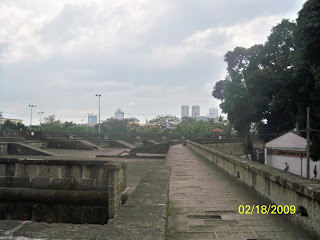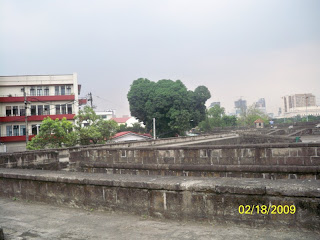The old historical photos posted here, I have personally copied from the Library of American Congress, University of Wisconsin's Digital collections, from other sources and the other photos were courtesy of SSC forumer “Animo” who posted the photos in the Skyscrapercity Retrato series and other historical threads in SSC Forum.
CIUDAD MURADA, means Walled City or Within the Walls.
At the tip of the tongue of land that was Maynila, Rajah Soliman had built a fort facing the mouth of the river and the sea. A palisade of logs (the trunks of coconut trees) was meant more to deflect gunfire than to enclose, since it was easy to pass between the logs, planted in the ground about a foot from each other. The fortification proper consisted of narrow mud walls mounted with a dozen pieces of artillery, mostly small-caliber cannon.
The town itself was a mass of nipa huts huddled around Soliman’s palace. There is no mention of a mosque. The palace was a big house with a lot of porcelain and blankets; a number of wooden tanks filled with water; and rich stores of copper, iron, wax, and cotton. Beside the palace was an arsenal. Nearby was a forge where cannon were made under the direction of a Portuguese armorer.
Maynila was considered a great city because it had a population of 4,000. Government was in the hands of two men. Apparently the previous king, Rajah Laya, had, because of old age, abdicated in favor of his nephew Soliman. But the young king kept his uncle on as adviser. So the old Laya held the position of elder statesman and was known as Rajah Matanda.
Maynila was not ignorant of white men; the Portuguese were already active in the Philippines. Still, the summer that brought the whites in large numbers to Manila Bay was epochal. With that summer, the history of Manila begins to have dates. We have entered the calendar of the West.
One day early in June, 1570, Soliman heard that a ship of the palefaces had entered the bay at sunset and anchored off Kawit. The palefaces were Kastila, not Portuguese. An evening conference with his uncle, Rajah Matanda, would have enlightened Soliman on the Kastila.
The old king would remember how, some forty years ago, there had been rumors of these palefaces coming to Cebu and converting the court to their religion. But when their leader was killed on Mactan, the palefaces had fled in terror.
Intramuros, located along the southern bank of the Pasig River, is the oldest among the districts of the city of Manila, the capital of the Philippines. Its name, taken from the Latin, intra muros, meaning "In the walls" also describes its structure as it is surrounded by thick, high walls and moats. During the Spanish Period, Intramuros was considered Manila itself.
The site of Intramuros was originally a large and prosperous Malayan Muslim settlement named Maynilad. The name came from may nilad, nilad being a water plant whose star-shaped flowers clustered in abundance along the low-lying riverbanks. The strategic location of Maynilad, being on the Pasig River and the Manila Bay, made it an ideal location for the locals to trade crafts and produce with other peoples of the then pre-Hispanic Philippines and other Asian countries, especially with ethnic Chinese merchants. Maynilad was also the seat of power for native chiefs who ruled the area before the Spaniards set foot on Philippine soil.
In 1570, Spanish conquistadors led by Martín de Goiti, Juan de Salcedo and Miguel López de Legazpi arrived in Manila. Goiti and Legazpi's men waged war on the Muslims and indigenous tagalog peoples before they were able to take control and establish a permanent settlment in the area. In 1571 after the Spaniards were victorious in battle, Legazpi made a peace pact with the native muslim rulers, who, in return, handed over Manila to the Spaniards. Citing the rich resources, strategic economic, political and military importance of Manila, Legazpi declared Manila as the new capital of the Spanish colony in the Philippines on June 24, 1571.
The King of Spain, delighted at the new conquest achieved by Legazpi and his men, awarded Manila a coat of arms and declared it Insigne y Siempre Leal Ciudad ("Distinguished and ever loyal city"). The planning of the city of Manila was commenced by the Captain General - Governor, Miguel López de Legazpi, who established forts, roads, churches and schools. The plans for Intramuros was based on King Philip II's Royal Ordinance issued on July 3, 1573 in San Lorenzo, Spain. Its design was based upon a medieval castle structure and covered 64 hectares of land, surrounded by 8 metre thick stones and high walls that rise 22 metres.
Fort Santiago
Intramuros Plan 1800
Intramuros Plan 1898
Intramuros was completed in 1606 and it served as the center of political, military and religious power of the Spaniards during the time that the Philippines was a colony of Spain. Inside Intramuros there are several Roman Catholic churches, like the Manila Cathedral and the San Agustin Church, convents and church-run schools such as the University of Santo Tomas, Colegio de San Juan de Letran and Ateneo Municipal, which were usually being run by religious orders such as the Dominicans, Augustinians and Franciscans.
The Governor's Palace, the official residence of Spanish Viceroyal ties to the Philippines was originally in Intramuros before it was officially moved to Malacañang Palace and Fort Santiago. Only Spaniards and Mestizos were allowed to take part on political issues and take residence inside the walled city, Christian natives and ethnic chinese were also allowed inside, but Spanish officials prevented them living there. The vast majority of the natives and ethnic Chinese residents lived outside the walled city.
Walled City 1925
During World War II, much of Intramuros was damaged by bombings from both Japanese who occupied it and used it as their headquarters and prison and by U.S. forces who besieged the Japanese.
Aerial bombs dropped in Manila by US planes.
Plaza Espana - 1945
Present Day
In the 1980's, under the direction of former Philippine First Lady Imelda Marcos, the Intramuros Administration restored the city and at present the walled city is the only district of Manila where old Spanish-era influences were retained. Much of the development of present-day Manila occurred outside the gates of Intramuros, leaving the old walls, streets and churches of Intramuros minimally touched by modernization, although outlets of Jollibee, McDonald's and Starbucks now sit alongside distinguished educational institutions within its walls. The old moats that surrounded Intramuros have been filled up and transformed into a golf course where locals and foreign nationals play the sport. The garrison that was Fort Santiago is now a tourist spot where visitors can enjoy the nostalgic romance of a bygone Spanish era within it's gardens.




















































































































An impressive collection of historic and contemporary image documentation of Intramuros. Thank you for sharing such valuable data on the "distinguished and ever loyal" city of Manila.
ReplyDeleteThanks for this great article.
ReplyDeleteGood day! I am a researcher from GMA News TV – Kiko Rustia presents: Dis Is Pinas. It is a weekly 30-minute block-timer program that features various Philippine heritage sites like landmarks, historical buildings and other significant natural structures.
ReplyDeleteWe would like to ask for your permission to borrow certain pictures found in your website. We will be using it as a material for our upcoming episode about Manila on June 21, 2014, Saturday 11:30am-12nn. Rest assured that we will give you proper courtesy/ credits for the pictures. If you could also provide us your email so that we could send our formal letter to you. Thank you and God bless!
Good day Joane,
ReplyDeleteIt is only today that, I checked the "comments" section of my blog and found your above comment.. Though it is already too late, I wish to give to you my advance permission to copy photos or anything in my Em Esber Blog 1 or in Em Esber Blog 2. My email address: emmanuel_esber@yahoo.com Best regards, Em Esber